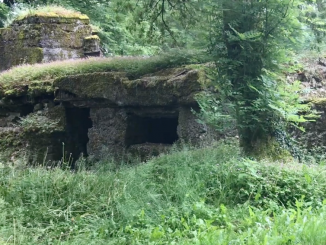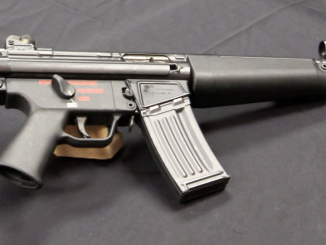Developed in the 1980s, the H&K PSG-1 is one of the most iconic sniper rifles in popular culture, with a reputation for unmatched accuracy. It is, in fact, an excellent rifle, and today we will look at why.
The PSG-1 was introduced in the 1980s and based on the German G3 rifle action. Onto this base, a heavy barrel was added, and stiffening bars welded to the sides of the receiver. A Hensoldt 6x42mm scope was added, with proprietary mounting points welded to the receiver. An adjustable buttstock was added (common today, but much more innovative at the time) allowing the shooter to change the comb height and length of pull. An excellent 3lb crisp trigger replaced the standard heavy and mushy G3 trigger. A forward assist was installed to allow for quiet closing of the bolt, and the extractor and locking rollers were redesigned.
All of these changed made for a very accurate and very expensive rifle, and one which would find its way into popular culture as one of the ultimate sniper rifles ever made. Perhaps surprisingly, it does actually live up to much of this hype, and is legitimately an excellent rifle – although intended more for police use than military.




One item which command attention IMO, is the fact that the rifle is Semi-automatic as opposed to manually operated. Germans had excellent tradition in bolt-action Mauser rifles and could use that knowhow rather easy to create sniper rifle; or just re-adapt something from past.
Therefor, one thought which comes to mind is perhaps a different approach to sniping for police force at that time. This concept would be easy to understand with military application on mind, but this is obviously not the case here.
Actually, a semi-automatic sniper rifle is even more important in a police role than in military usage. When you are in a situation with multiple hostage takers, you really want to take all of them out simultaneously or at least very quickly. Ideally, you’d have one sniper for every hostage taker each, but even then – if one of the snipers misses, he (or one of the other snipers who have already dealt with their tango) really has to be fast with his second shot.
Although military tactics and actual combat heavily rely on volume of fire and therefore obviously benefit from the introduction of semi-automatic rifles, fast follow-up shots are not only desirable, but absolutely essential for police sniping.
I am in line with your thinking and appreciate your input.
What pops into my awareness now is what was said about L129 – kind of similar topic. It was a point of high interest for me that Ian mentioned role of mass/ weight in deciding what brand/ model was selected. I suppose it this case it is also an ingredient.
“mass/ weight”
A.A.Blagonravov (Основы проектирования автоматического оружия, 1940) uses term коэффициент использования металла which is ratio: bulletMuzzleEnergy to weaponMass, this is rough formula as it don’t counter magazine capacity or RateOfFire and different categories can’t be compared (for example single-shot non-automatic vs machine-gun), but if used properly bigger value more rational design. Machine gun might be considered with mount or without mount (gun only).
Interesting stuff Daweo, as always from you.
It appears to me however, that designers did not learn as yet to cope with issues in some pro-active way, such as recoiling mechanism which would absorb part of recoil energy instead of letting it passively act onto frame of weapon. Maybe I am not quite aware of what was done thus far.
PS: In Fürstenfeldbruck, German police had five “snipers” (actually, just regular police officers who were selected on basis of their military training and who were given G3s) for eight hostage takers – five on eight. Remember, the whole German doctrine for counter-terrorism was heavily influenced, if not mainly based on the traumatic experience of Munich/Fürstenfeldbruck, so having a semi-auto sniper rifle was top priority when creating GSG9 and the state-police based SEK units.
Actually, Munich police had adopted the Steyr SSG 69 just shortly before the Munich hostage crisis (they were available at Fürstenfeldbruck, but no officers had been trained in them, so the commanding officer decided to use the less-precise, but semi-automatic G3s instead). After Fürstenfeldbruck, German police generally left manually operated sniper rifles.
Perhaps a nod to the lessons learned from the Munich Massacre: fast, accurate, repeat firing.
Probably should have watched the video before responding 😛
Right, makes sense… although there are some handy and fast shooting repeaters too.
Oh yes, and I missed this badly… on 22.Noveber 1963 even old shitty Carcano made wonders. -:)
“fast shooting repeaters”
For example of such weapon used by police see Mauser SP66:
http://modernfirearms.net/sniper/sniper-rifles/de/mauser-sp66-e.html
Yesss, that’s what I meant in my initial remark.
In the large scale, there were different schools of thought on the ideal sniper rifle. Semiautomatics were favoured by some because it removed the major motion of having to work the bolt which some felt would compromise the shooter’s position. Evidently these people did not consider flying brass to be as much of a problem as the manually operated community felt. M21, MSG90, SVD, any of the optic-equipped battle rifles, all demonstrate that this position was broadly held; so it may well have been seen as natural from the developers’ point of view to start with the semiauto as a basic principle. With a small number of police shooters in an elite CT unit you’d think that regardless of semiauto or bolt, they’d be well enough trained to very rapidly follow up shots – or there’d be a situation in which multiple shooters are engaging the same target, for example on the classic “behind a window” two shooters arrangement.
“SVD”
Although it must be noted that this weapon was not designed as pure sniper weapon (i.e. to be used by snipers or snipers teams) but rather to be used inside regular units, which would make it designated marksman rifle from today point-of-view.
I read time ago (I believe it was on TFB) about Russian gun-smith who substantially upgraded SVD as a private venture. I cannot get the name right now, but result was impressive – true modern looking rifle with improvement on all levels.
“substantially upgraded SVD”
ИжМаш developed enhanced SVD variants:
http://weaponland.ru/load/snajperskaja_vintovka_svdsm_svdm/88-1-0-583
namely SVDSM and SVDM, first differs by having folding stock (hence second “S”), many parts in these rifles were originally designed for СВ-98.
“substantially upgraded SVD”
And there is also OTs-03 developed in Tula:
http://modernfirearms.net/sniper/sniper-rifles/rus/svu-and-svu-a-e.html
which represents much different approach and greatly improves barrel-length to overall-length ratio.
“substantially upgraded SVD”
Yet another approach is SVDK:
http://modernfirearms.net/sniper/sniper-rifles/rus/svdk-e.html
which is intended for 9.3×64 cartridges.
They look all good Daweo and prove that Russian military industry is trying to keep “dragon” alive and well into future.
I found the article about SVD upgrade by Genady Kozhaev:
http://www.thefirearmblog.com/blog/2012/02/24/magpulized-russian-dragunov-svd-rifle/
Be interesting to see a shootoff between this and a modern semi auto snipers rifle like a SASS M110 or the like.
Very interesting video, thanks. With this and a pair of Addidas GSG9 boots I should be GTG, right? 😉
I have a german book about the GSG-9 from the nineties by Reinhard Scholzen. It has quite a lot of photos about the armaments. In the eighties, the basic building block of the GSG-9 was the SET Spezialeinsatzteam, made up of five men. Each of these SET had in their armament two sniper rifles, a PSG-1 and a Mauser SP-66 bolt-action sniper rifle. Depending on the operation, a SET would function as a assault team or as a sniper team (thats how it was in the eighties).
“Walther” in German is pronounced if it were English as “Valter.” (A “W” auf Deutsch sound like a “V” in English.”
“Waffenfabrik” in English would be written “Vaffen-fa-breek”, run together very fast.
Can’t remember where the emphasis goes. Probably on “Waffen.”